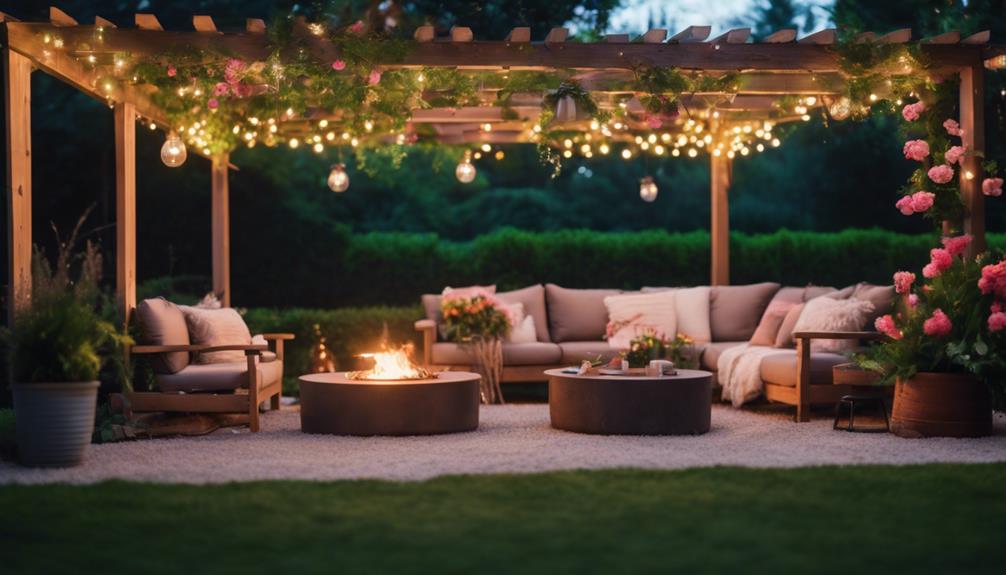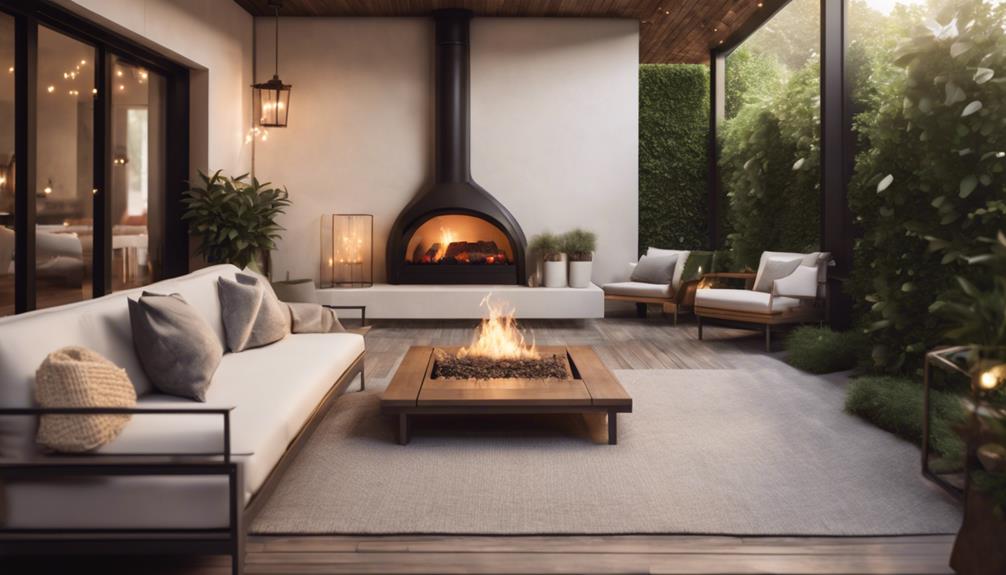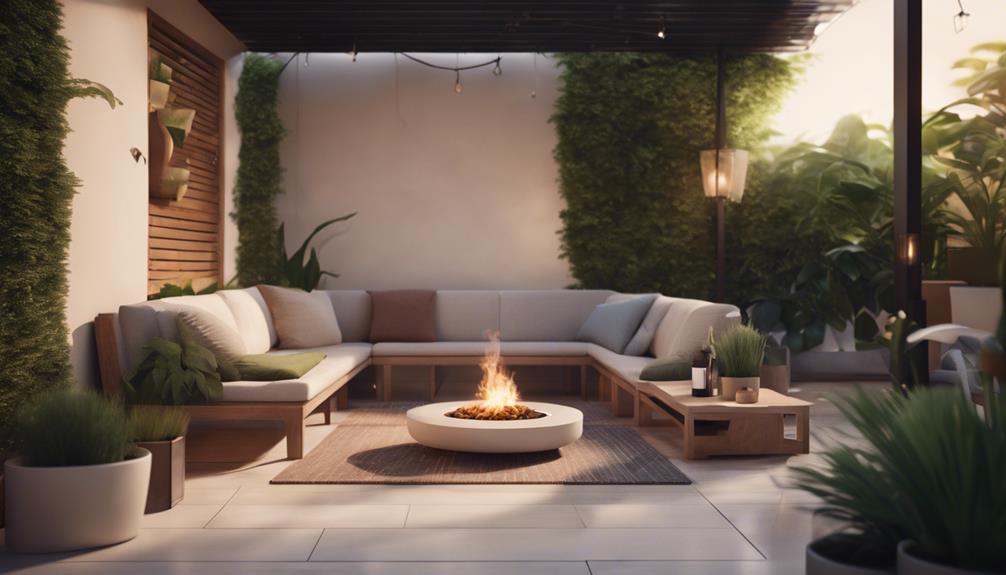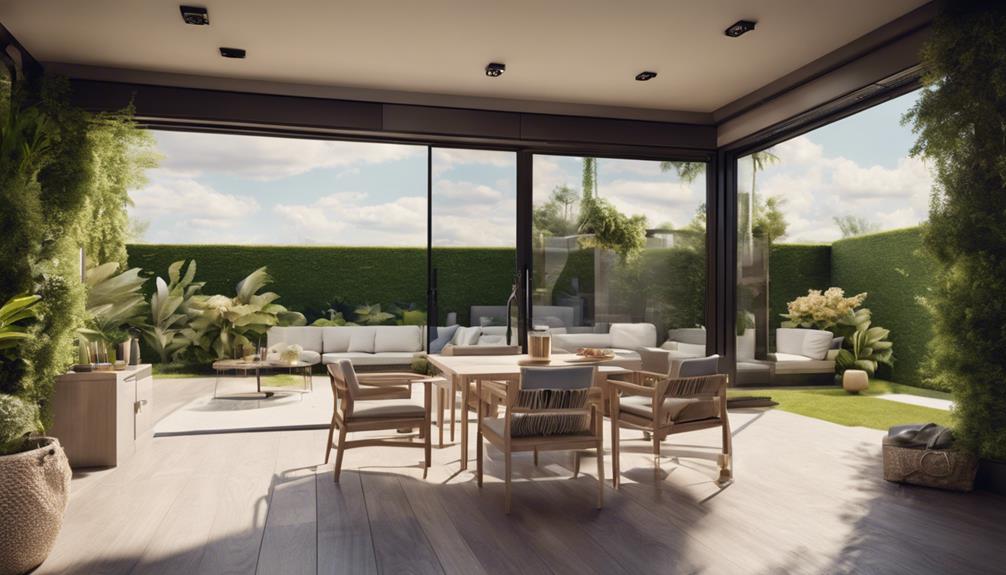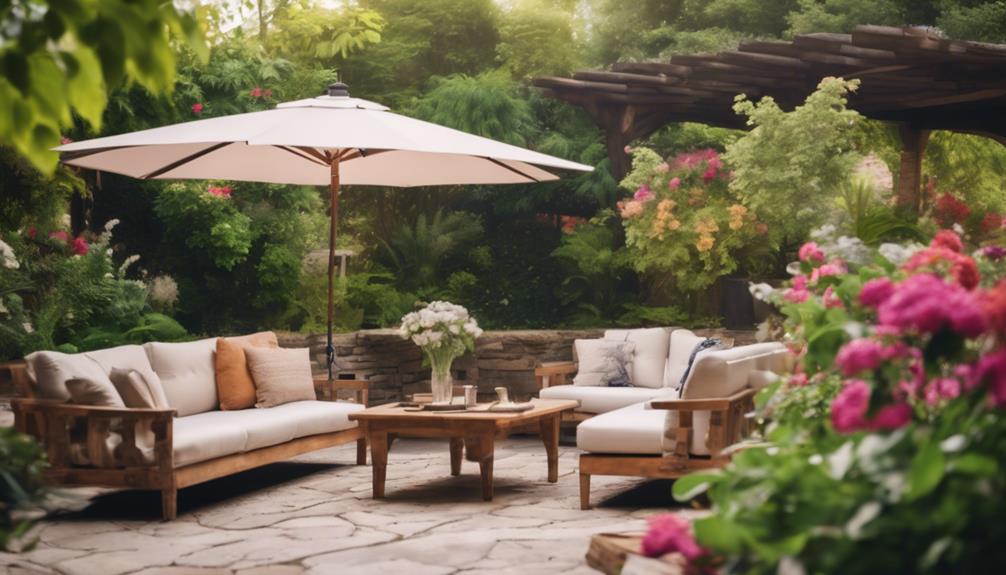You're ready to transform your backyard into a stunning alfresco oasis! Start with cozy seating areas, like Adirondack chairs or hammocks, and add ambiance with outdoor rugs and throw pillows. Don't forget a dining space with a sturdy table, comfy seating, and string lights. Consider nature-inspired designs, incorporating wood, stone, and plants. To take it to the next level, explore outdoor room essentials, patio decor inspiration, and outdoor living trends. Get ready to unwind and entertain in style! Now, let's dive deeper into the world of outdoor alfresco ideas and discover even more secrets to creating your dream backyard retreat.
Key Takeaways
- Create a cozy ambiance with outdoor seating, lighting, and textiles that reflect your personal style and complement your backyard's natural beauty.
- Designate different areas for lounging, dining, and socializing to create a functional and inviting outdoor space.
- Incorporate natural elements like wood, stone, and plants to bring warmth and texture to your outdoor space.
- Use outdoor rugs, throw pillows, and decorative elements to add color, pattern, and personality to your alfresco area.
- Consider sustainable and eco-friendly options for your outdoor decor and furniture to reduce your environmental footprint.
Outdoor Seating Inspirations
To create an inviting outdoor space, consider incorporating outdoor seating inspirations that not only provide comfort but also add style and functionality to your alfresco area.
You'll want to start by thinking about the type of outdoor furniture that'll work best for your space. Maybe you're looking for a classic look with Adirondack chairs or a more flexible option like armchairs that can be rearranged to suit your needs.
If you want to create a cozy outdoor lounge, consider adding hammocks or benches for a relaxing vibe.
Think about the seating arrangement that'll work best for you and your family. Do you need a lot of extra seating for guests, or is a smaller, more intimate space what you're after? Whatever you choose, make sure it's comfortable and functional.
Don't forget to add some decorative elements like outdoor rugs, throw pillows, and wind chimes to really make your outdoor seating area come alive.
With a little creativity, you can create an outdoor space that's perfect for relaxing, entertaining, or just enjoying the great outdoors.
Alfresco Dining Spaces
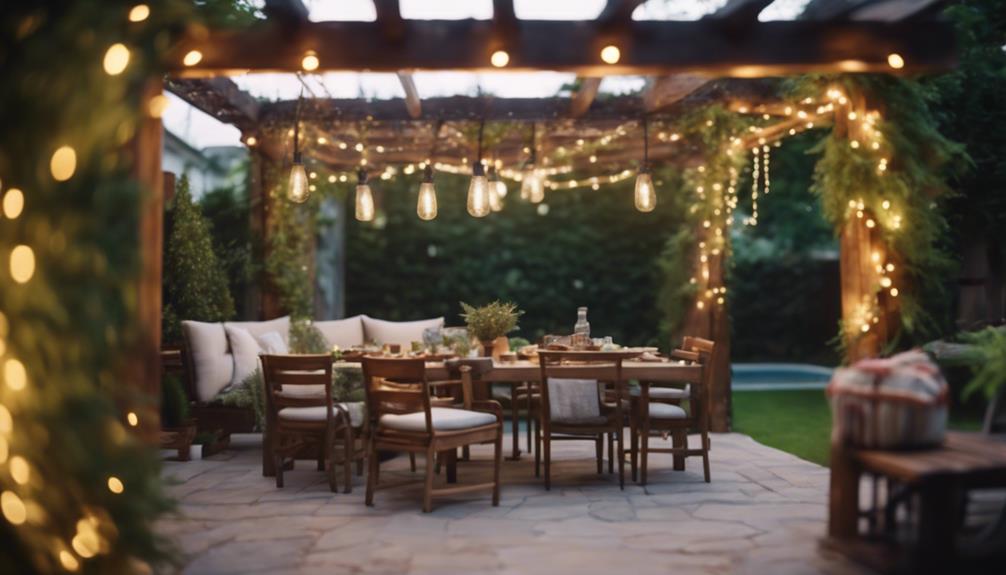
Create an alfresco dining space that's perfect for savoring meals under the sun or stars by incorporating a few essential elements. You'll want to start with a sturdy dining table that can withstand the outdoor elements. Pair it with comfortable seating that invites lingering conversations and relaxation.
Don't forget to add an outdoor kitchen or barbecue to make cooking and entertaining a breeze. Imagine being able to grill up a storm while your guests mingle around the alfresco area.
To take your space to the next level, consider adding some ambiance with string lights or lanterns. This will allow you to enjoy meals long after the sun sets.
Cozy Corner Ideas
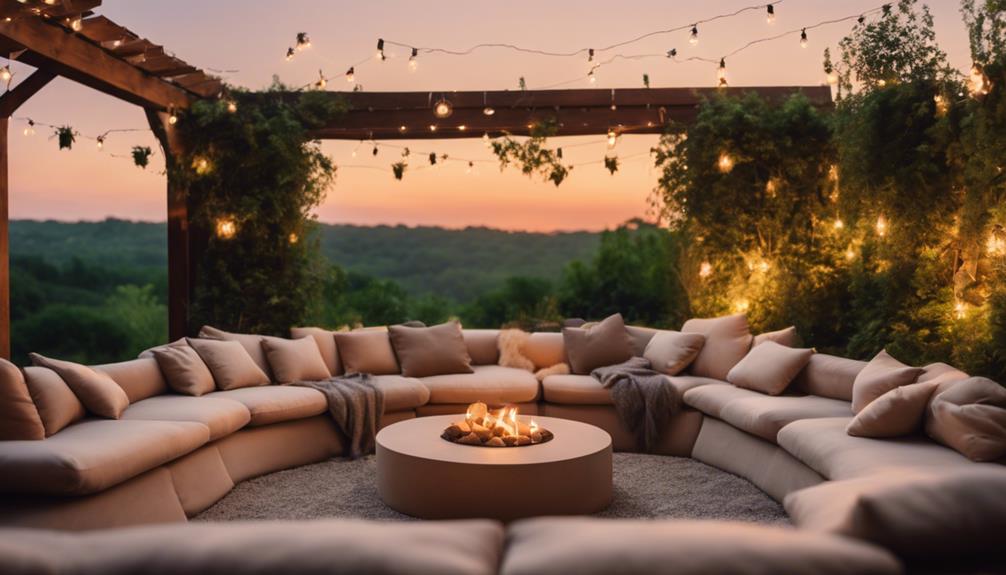
As you create your cozy corner, you'll want to start with the essentials: a comfy seating spot that invites lounging.
Next, think about setting the mood with soft, warm lighting that makes you feel all snug and fuzzy inside.
Cozy Seating Options
You can craft a cozy outdoor oasis by selecting the right seating options that invite relaxation and conversation. Imagine gathering around a fire pit with friends and family, or lounging in a hammock with a good book. The right seating can make all the difference in creating a cozy corner that beckons you to stay awhile.
Here are some cozy seating options to explore:
| Seating Option | Description |
|---|---|
| Hammock | Relax in style with a hammock, perfect for a lazy afternoon |
| Adirondack Chairs | Classic and timeless, these chairs invite relaxation |
| Circle of Lounge Chairs | Gather 'round the fire pit for intimate gatherings |
| Wooden Benches | Charming and lightweight, perfect for small spaces |
| Folding Chairs | Flexible and easy to store, great for small outdoor spaces |
Choose the seating option that suits your outdoor style, and get ready to cozy up in your backyard oasis!
Soft Lighting Ideas
Soft lighting transforms your outdoor alfresco space into an intimate retreat, perfect for relaxation and entertaining under the stars. Imagine sipping a rejuvenating cocktail or sharing laughs with friends under the gentle glow of string lights or lanterns. You can create a magical ambiance that makes your outdoor space feel cozy and inviting.
When it comes to patio ideas, soft lighting is a must-have. It's not just about illumination; it's about setting the mood. LED candles, solar-powered lights, or fairy lights can add a soothing and inviting touch to your outdoor space. Plus, with dimmable lighting options, you can adjust the brightness to suit different moods and occasions.
Whether you're hosting a dinner party or a casual gathering, soft lighting can make all the difference. So, get creative and experiment with different lighting ideas to create the perfect atmosphere for your next outdoor gathering. Remember, it's all about creating a space that feels relaxing, inviting, and perfect for making memories with loved ones.
Nature-Inspired Textiles
To further enhance the ambiance of your outdoor alfresco space, incorporate nature-inspired textiles that bring the outdoors in, creating a cozy corner that's perfect for relaxation and conversation.
You can achieve this by using earthy tones and botanical patterns, which will create a sense of calm and connection to nature.
To add an organic feel to your outdoor living space, incorporate natural fabrics like linen, cotton, and jute into your decor. Throw pillows, blankets, and rugs with nature-inspired designs can evoke a sense of tranquility and bring the outdoors in.
Mixing textures like knits, weaves, and embroidery can add depth and visual interest to your cozy corner.
Consider using materials like bamboo, rattan, and wood for furniture to complement the nature-inspired textiles in your alfresco area.
Nature-Inspired Designs
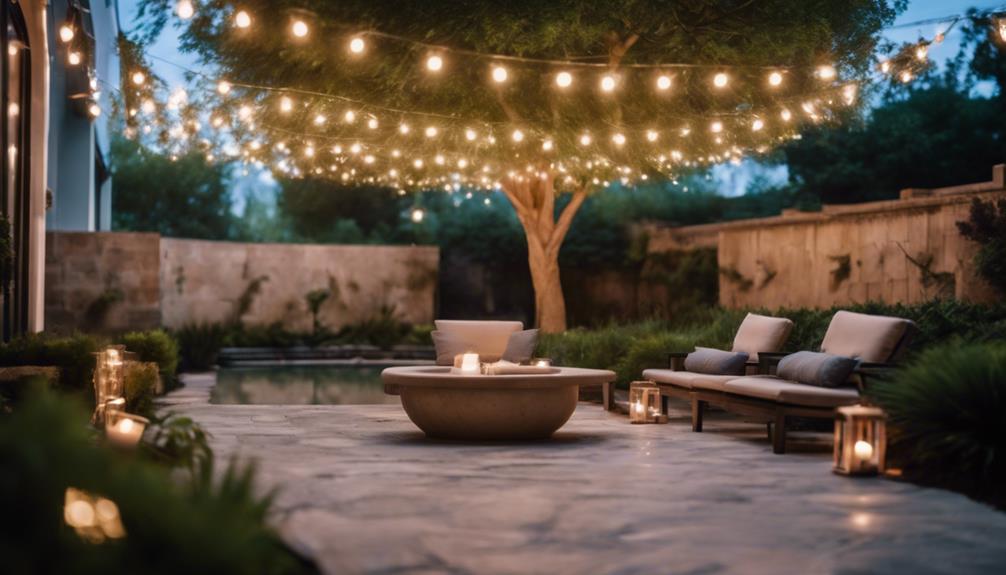
Incorporating natural elements into your outdoor alfresco design creates a serene and inviting atmosphere that mirrors the beauty of nature itself. You can bring the outdoors in by incorporating natural elements like wood, stone, and plants into your outdoor living spaces.
Earthy color palettes and organic textures can also help create a sense of harmony with nature. To take it to the next level, consider adding water features like fountains or ponds to create a soothing ambiance.
Don't forget to maximize natural light by strategically placing windows or openings, blurring the lines between indoor and outdoor areas. When choosing furniture and decor, opt for eco-friendly materials like bamboo or rattan to enhance the natural vibe.
Outdoor Room Essentials
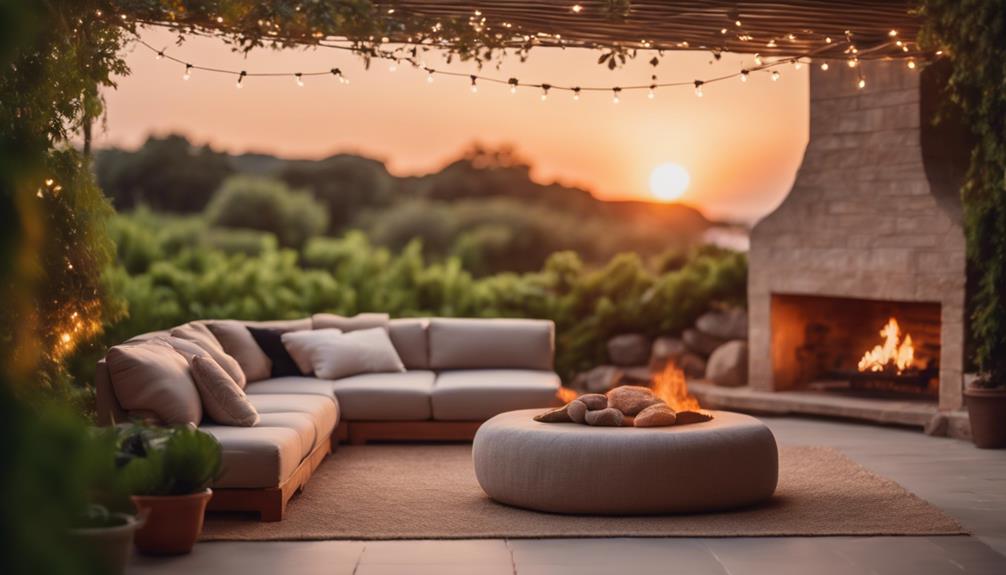
As you design your outdoor alfresco space, you'll want to focus on the fundamentals that turn it into a comfortable and functional extension of your home, starting with the right seating, dining areas, and lighting. These outdoor room essentials will create a cozy atmosphere, perfect for relaxing and entertaining.
To get started, consider the following elements:
| Element | Description |
|---|---|
| Seating Areas | Comfortable outdoor furniture, like sofas and armchairs, create inviting spaces for lounging and socializing. |
| Dining Area | A designated dining space with a table and chairs allows for al fresco meals and gatherings. |
| Lighting | String lights, lanterns, or table lamps add ambiance and functionality to your outdoor room. |
| Decor | Incorporate outdoor rugs, throw pillows, and curtains to enhance the space and create a seamless flow between indoor and outdoor areas. |
Backyard Oasis Concepts
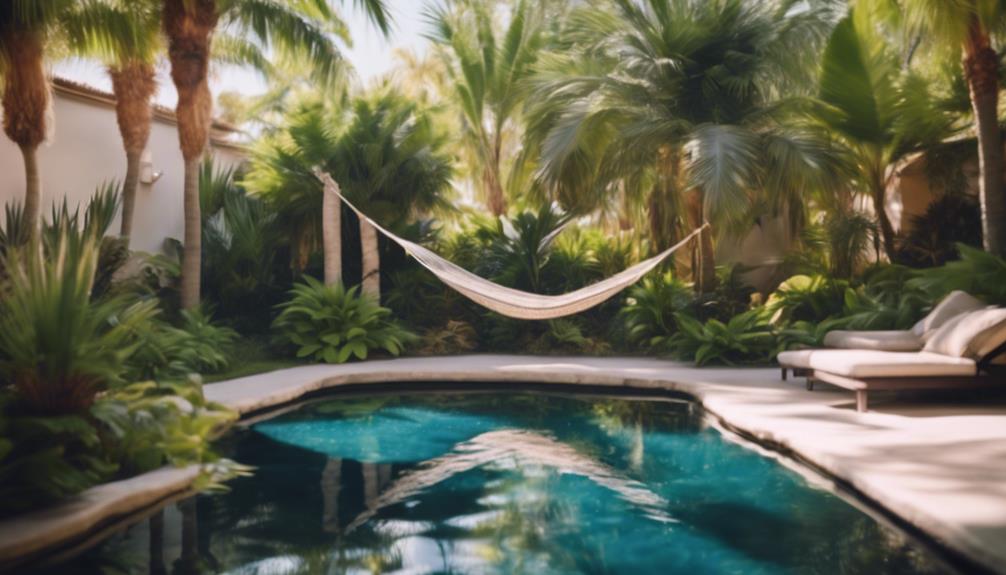
Transform your backyard into a serene retreat by combining inviting seating areas, lush greenery, and functional spaces that foster relaxation and entertainment.
Imagine having an outdoor living room where you can unwind with family and friends. You can create this haven by incorporating multiple seating areas, each designed for a specific purpose, like a cozy nook for reading or a lounge area for socializing.
Here are some ideas to get you started:
- Design a modern farmhouse-inspired outdoor space with a rustic outdoor fireplace as the centerpiece.
- Incorporate a water feature, like a small pond or fountain, to create a soothing atmosphere.
- Build an outdoor kitchen or BBQ area, complete with a pergola and string lights, perfect for alfresco dining and entertaining.
Patio Decor Inspiration
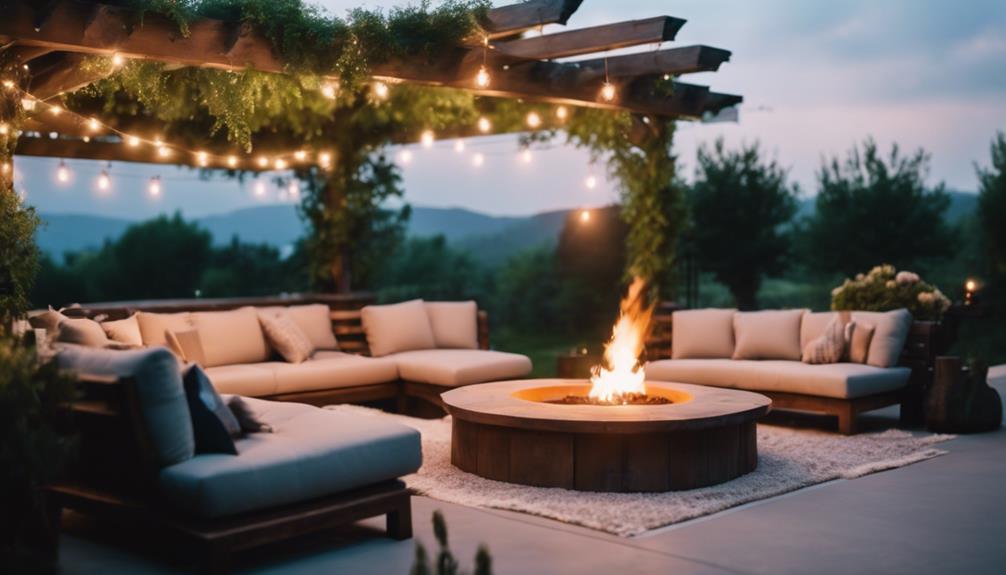
You can elevate your patio's ambiance by thoughtfully selecting furniture and decor that reflect your personal style and create a vibrant atmosphere. A cozy seating area with colorful accent pillows can instantly transform your patio into a warm and inviting space. Consider custom-made furniture pieces to add a unique touch and personality to your outdoor space. Don't be afraid to opt for bold colors to liven up the atmosphere and create a cheerful outdoor setting.
Design a welcoming outdoor space with long sofas adorned with eye-catching pillows for a lively ambiance. Alternatively, choose sleek and minimalist outdoor furniture for a modern and stylish patio decor. Remember, it's all about creating a space that reflects your personality and style.
Outdoor Living Trends
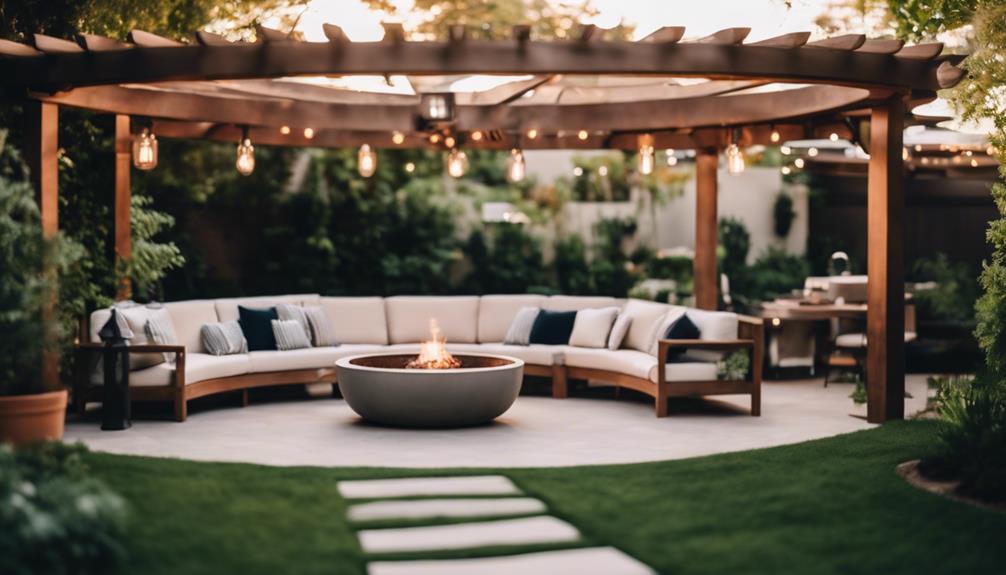
Now that you've got your patio decor inspiration sorted, it's time to explore the latest outdoor living trends that'll elevate your alfresco space to the next level!
You'll want to contemplate clever outdoor room design, sustainable decor options that are kind to the planet, and nature-inspired accents that bring the outdoors in.
Outdoor Room Design
As you plan your outdoor space, consider incorporating cooking, dining, and lounge zones to create a functional and stylish living area that extends your home's interior. This outdoor room design trend is all about creating an alfresco area that's perfect for relaxation and entertainment.
To get started, think about how you want to use your outdoor space. Do you want a cozy lounge area for lazy Sundays or an outdoor kitchen for summer barbecues?
Here are some ideas to get you started:
- Use natural color palettes and timber decking to bring the outdoors in and create a seamless shift between your indoor and outdoor spaces.
- Create ambiance with lighting – string lights, lanterns, or fairy lights can add a magical touch to your outdoor room.
- Don't forget about functionality – incorporate storage and shelving to keep your outdoor space organized and clutter-free.
Sustainable Decor Options
By opting for sustainable decor options, you can create an eco-friendly alfresco space that not only complements your outdoor room design but also reduces your environmental footprint.
You can start by choosing eco-friendly materials like recycled plastic, reclaimed wood, and natural fibers for your outdoor furniture and decor. These materials aren't only good for the planet, but they also add a unique touch to your outdoor space.
Another way to go green is by using energy-efficient outdoor lighting. Solar-powered fixtures are a great option, and they'll save you money on your electricity bill too!
You can also incorporate native plants and drought-resistant landscaping in your outdoor area. Not only will they require less maintenance, but they'll also attract local wildlife and support the local ecosystem.
Nature-Inspired Accents
Bring the outdoors in by incorporating natural elements like wood, stone, and greenery into your alfresco design to create a nature-inspired ambiance that mirrors the beauty of the great outdoors. You can achieve this by incorporating earthy tones, textures, and organic shapes that mimic the beauty of nature in your outdoor living space.
Here are some ideas to get you started:
- Opt for furniture and decor that reflects the outdoors, such as rattan chairs, wooden tables, and plant-filled pots.
- Enhance the natural feel with soft lighting, cozy textiles, and nature-themed artwork in your alfresco design.
- Create a smooth shift between indoor and outdoor spaces by incorporating natural accents like potted plants, hanging vines, and natural light.
Backyard Retreat Ideas
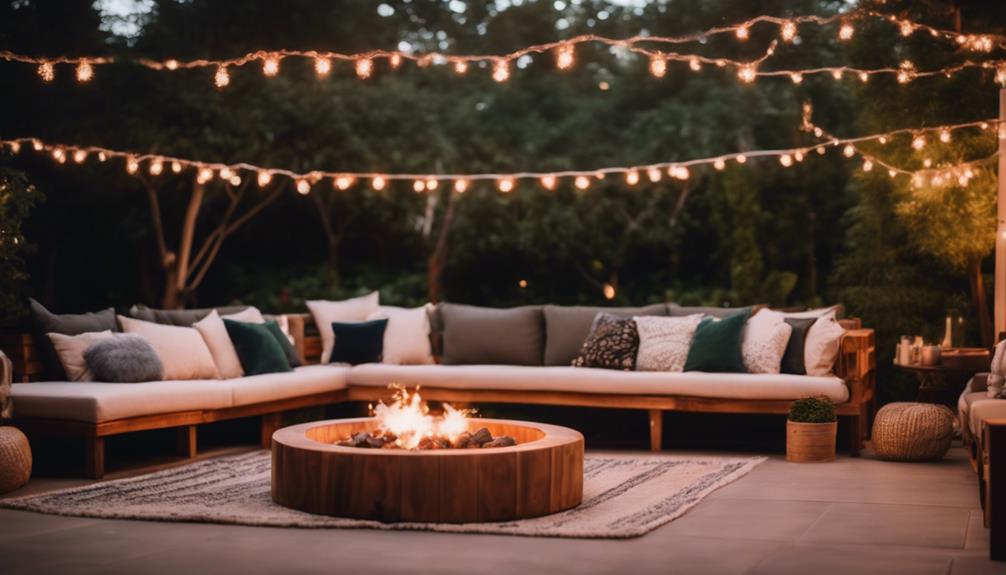
How do you envision your ideal backyard retreat, where you can unwind and escape the stresses of everyday life?
Imagine creating an outdoor space that's all about relaxation and tranquility. You can start by setting up cozy seating areas with comfortable outdoor furniture, like lounge chairs or a hammock. Add some ambient lighting to create a warm and inviting atmosphere, perfect for a chill evening with family and friends.
To take your backyard retreat to the next level, consider incorporating water features like a fountain or pond. The soothing sounds of water will help calm your mind and create a peaceful ambiance.
If you want to make your outdoor space even more comfortable, think about adding a fire pit or outdoor fireplace for those cool evenings. And don't forget to provide some shade with a pergola or shade sail, so you can enjoy your backyard retreat regardless of the sun's position.
With these elements, you'll be well on your way to creating a serene outdoor oasis that's all your own.
Alfresco Style Inspiration
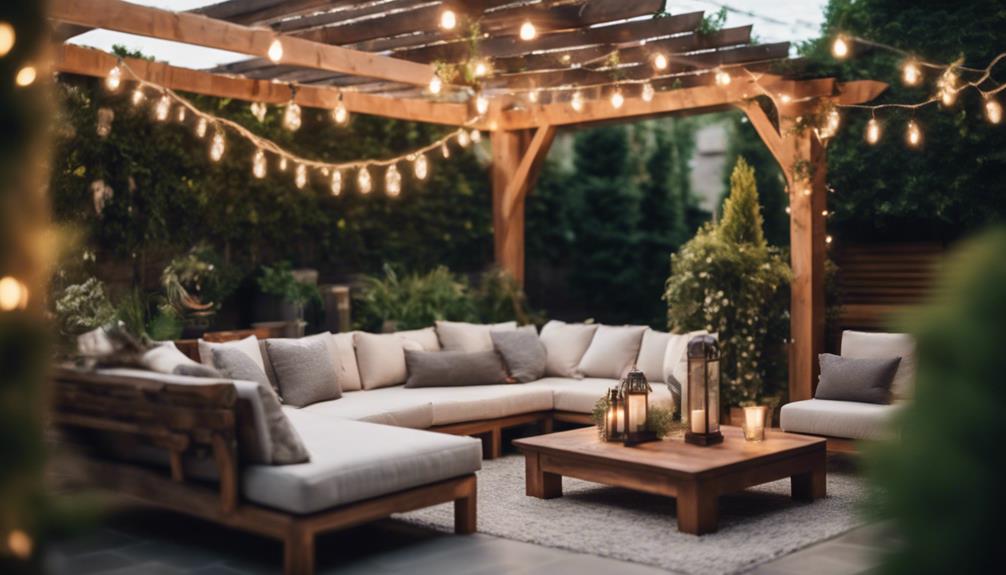
Now that you've got a solid foundation for your outdoor space, it's time to think about the style that'll make it truly shine!
You can opt for Coastal Chic Vibes that evoke the feeling of a beachside retreat, go for Rustic Country Charm that's perfect for a countryside escape, or create an Urban Oasis Ambience that's ideal for city dwellers.
Whichever style you choose, it'll be the key to turning your outdoor space into a true haven.
Coastal Chic Vibes
To evoke the carefree essence of a seaside retreat, you can infuse your alfresco space with coastal chic vibes by incorporating natural elements, subtle nautical accents, and soothing color palettes. This style combines the best of the coast, bringing the beach to your backyard!
For a coastal chic outdoor space, consider these ideas:
- Incorporate natural elements like timber decking and sea-inspired colors to create a relaxed and inviting atmosphere.
- Add coastal elements like driftwood, rope accents, and nautical decor to enhance the beachside vibe.
- Use soft, neutral tones paired with pops of blue and green to evoke a sense of serenity and bring the coastal chic theme to life.
Rustic Country Charm
Bring the warmth and coziness of rural living to your outdoor space by embracing rustic country charm, where natural materials, vintage accents, and earthy tones come together to create a cozy retreat. Imagine sipping lemonade on a warm summer evening, surrounded by the tranquility of the countryside. To create this ambiance, incorporate natural materials like wood and stone into your outdoor design. Add a touch of nostalgia with vintage and antique elements, such as old lanterns or distressed wooden benches.
Here are some rustic country charm ideas to get you started:
| Element | Description | Tips |
|---|---|---|
| Natural Materials | Wood, stone, and plants | Use reclaimed wood for a unique look |
| Vintage Accents | Old lanterns, distressed furniture | Mix with modern pieces for contrast |
| Earthy Tones | Warm neutrals, like beige and green | Add pops of color with throw pillows |
| Rustic Furniture | Wooden benches, stone tables | Add comfy cushions for cozying up |
| Decor Pieces | Vintage signs, galvanized tubs | Add personal touches, like family photos |
Urban Oasis Ambience
As you step into your backyard, transform it into an urban oasis ambience by blending sleek, modern furniture with lush greenery. Imagine yourself surrounded by contemporary design elements, minimalist decor, and geometric shapes that exude a sense of calm and serenity.
To create this ambiance, consider the following ideas:
- Incorporate modern furniture with clean lines and minimalist decor to create a sleek look.
- Add lush greenery, such as potted plants or a living wall, to bring in a touch of nature.
- Utilize lighting features like string lights or solar-powered fixtures to create a cozy atmosphere.
In your backyard space, incorporate contemporary design elements to create a seamless blend of modernity and nature. By combining modern furniture with lush greenery, you'll create an urban oasis ambience that's perfect for relaxation and entertainment.
Frequently Asked Questions
What Is the Difference Between a Patio and an Alfresco?
So, you're wondering what sets a patio apart from an alfresco?
Well, here's the deal: a patio is basically an outdoor space attached to your house, usually made of pavement.
An alfresco, on the other hand, is a covered outdoor area designed for dining or entertaining, often with fancy features like built-in kitchens or fireplaces.
Think of it this way: a patio is more exposed to the elements, while an alfresco provides shelter from the sun, rain, and wind.
Does Alfresco Add Value?
So, you're wondering if an alfresco area is just a fancy patio or if it's actually worth the investment? Well, let's get straight to it – yes, an alfresco area can greatly enhance your property's value!
It's not just a pretty face; a well-designed alfresco space can increase your property's appeal and functionality, making it a desirable feature for potential buyers.
How Much Does It Cost to Build an Alfresco?
So, you're wondering how much it costs to build an alfresco? Well, the price tag can vary wildly depending on factors like size, materials, and features.
On average, you're looking at $10,000 to $30,000. Simple setups are cheaper, while fancy designs with high-end materials can cost more.
Don't forget to factor in extra expenses like lighting, heating, and furniture!
How to Decorate a Small Alfresco?
Decorating a small alfresco area can be a challenge, but don't worry, you've got this! Start by choosing slim furniture and space-saving designs to maximize your space.
Add some vibrant accent pillows and bold colors to create a lively atmosphere. Consider custom-made furniture and colorful textiles to give your outdoor space a unique touch.
And don't forget to create cozy seating areas with whimsical decor to make your alfresco area truly magical!
Conclusion
You've made it to the end of our outdoor alfresco ideas journey!
Did you know that spending time outdoors can reduce stress levels by up to 70%?
It's no wonder why creating an inviting alfresco space is a must-have for a happy and healthy lifestyle.
Take the inspiration you've gathered here and get creative with your backyard.
Remember, a little outdoor love can go a long way in improving your overall well-being!
